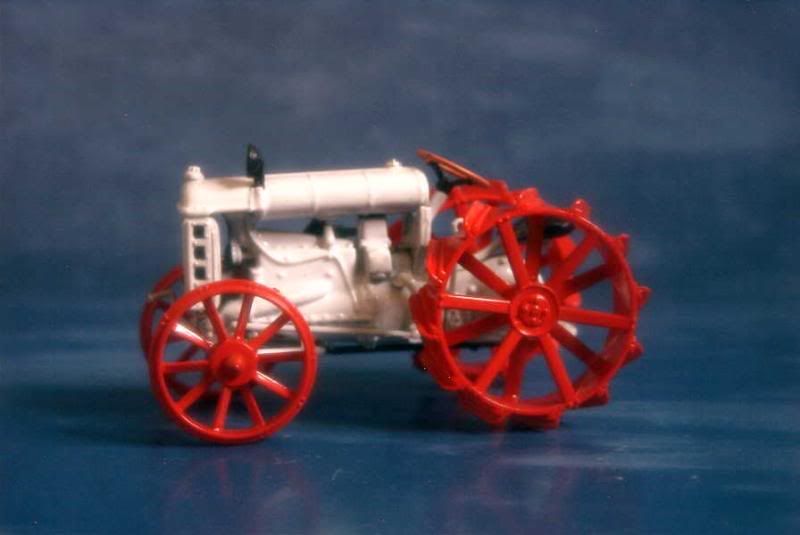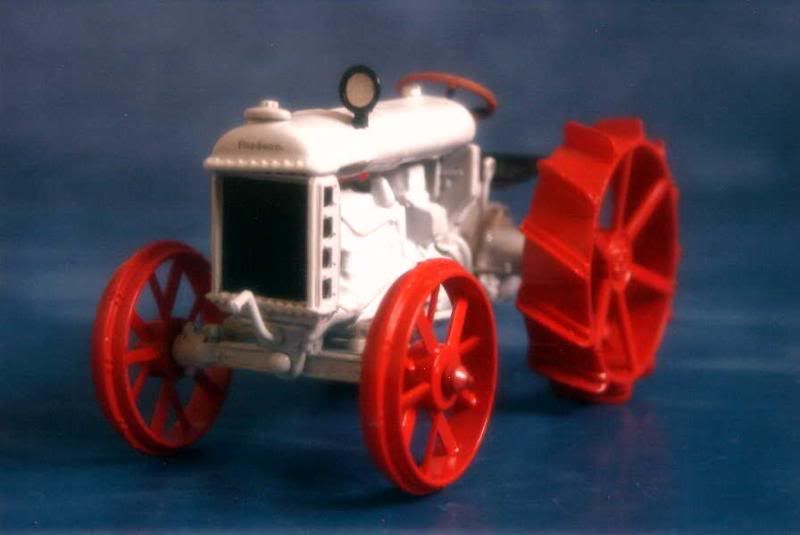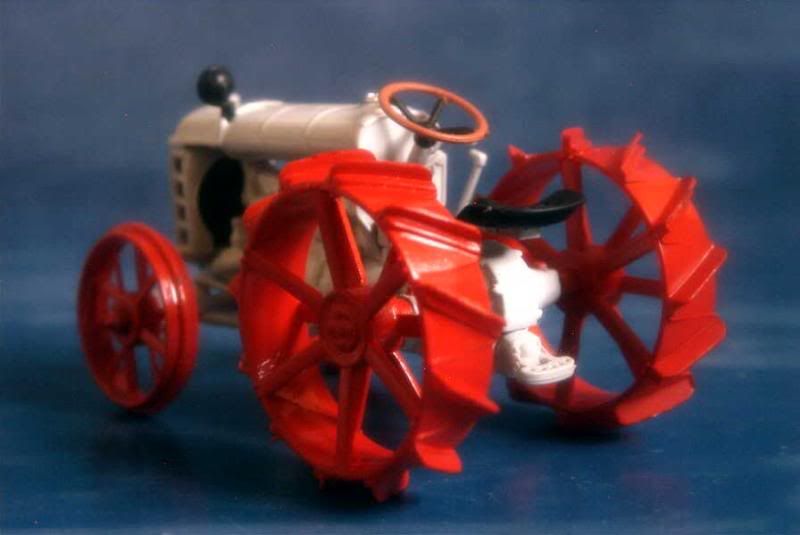No, this blog isn't hibernating once again, I simply experienced troubles with my computer for the last three weeks. Too bad as I actually had two posts ready for publishing... So now that the problem is solved, here's the first one.
Just before we start, welcome to our newest friends eviL hanZeL and Craig Hover, who just brought the total of followers up to twenty. Thanks guys, and enjoy your stay here!
A little history
Hear the name “Ford” and the word “car” will instantly come to your mind. Nevertheless, in the early days Henry Ford was eager to renew its Model T’s success in various fields, most notably aviation (the Ford Trimotor - which wasn’t an in-house design - flew during the late Twenties; a few of them were still in operation a few years ago) and agriculture.
Henry Ford himself came from a family of farmers, so being interested in the mechanization of agriculture was rather normal. As early as 1907, Ford started toying with the idea of building a tractor. During 1916, the prototype of the Model F was running and, by 1917, it went into production in a dedicated factory, especially erected for it in Dearborn.
The Model F was simply revolutionary. Early tractors were massive machines, often moved by steam or two-stroke diesel engines. Ford’s tractor was a simple, nimble, cheap apparatus that used a 20-hp, 4-cylinder gasoline engine and as many parts as possible from the Model T automobile. A particular care had been taken in protecting all mechanical parts from dust, a common source of breakdowns for early tractors. Purchasing a Model F was a 750-dollar investment for a farmer, but the machine allowed large savings over the traditional use of horses.
Success was instant for the Model F, and for a time the same bright future could be foreseen for Ford’s tractor as for its automobile. By 1922, 70% of all new tractors sold in the United States were Fordsons. Alas for the Dearborn company, a combination of fierce competition (International Harvester battled hard with Ford for the first place, as Chevrolet did simultaneously on the car market) and sales’ stagnation (a large share of American farms being motorized by then, the rest being too modest to afford a tractor anyway, particularly after agriculture entered a decline in 1925) decided Ford to abandon the production of its Model F in North America in 1928. Production of a new tractor, the Model N, would continue in Cork, Ireland, where production of Fordson tractors had started as early as 1919. More than 552,000 Model F had been built in America alone when production ended, a sizeable share of this output being shipped, quite surprisingly, to Soviet Union.
By the way, you perhaps wonder why the company’s automobiles were named “Ford”, its airplanes “Ford”, but its tractors “Fordson”? Well, despite keeping the development of its tractor secret, some information were leaked. Seeing a good opportunity for publicity, a group of businessmen from Minneapolis set up a Ford Tractor Company, using the name of one of their engineers. This venture didn’t go far, but the move forbade Ford from using its own traditional name for its newest product. Tractors were therefore produced by a division of Ford, Henry Ford and Son, shortened into “Fordson”.
About the model
Model: Fordson Model F
Year: 1917
Maker: Universal Hobbies
Scale: 1/43
Distributed by: Hachette as no.23 of its Tracteurs et Monde Agricole press series
Acquired: brand new, in April 2007, in Souillac, France
A nice little model, though quality of assembly could have been better. If I remember well the tractor itself is made from plastic parts, while the wheels are uncharacteristically made in metal. Nice to put on a shelf next to a Model T! 12/20 for this model.




Just before we start, welcome to our newest friends eviL hanZeL and Craig Hover, who just brought the total of followers up to twenty. Thanks guys, and enjoy your stay here!
A little history
Hear the name “Ford” and the word “car” will instantly come to your mind. Nevertheless, in the early days Henry Ford was eager to renew its Model T’s success in various fields, most notably aviation (the Ford Trimotor - which wasn’t an in-house design - flew during the late Twenties; a few of them were still in operation a few years ago) and agriculture.
Henry Ford himself came from a family of farmers, so being interested in the mechanization of agriculture was rather normal. As early as 1907, Ford started toying with the idea of building a tractor. During 1916, the prototype of the Model F was running and, by 1917, it went into production in a dedicated factory, especially erected for it in Dearborn.
The Model F was simply revolutionary. Early tractors were massive machines, often moved by steam or two-stroke diesel engines. Ford’s tractor was a simple, nimble, cheap apparatus that used a 20-hp, 4-cylinder gasoline engine and as many parts as possible from the Model T automobile. A particular care had been taken in protecting all mechanical parts from dust, a common source of breakdowns for early tractors. Purchasing a Model F was a 750-dollar investment for a farmer, but the machine allowed large savings over the traditional use of horses.
Success was instant for the Model F, and for a time the same bright future could be foreseen for Ford’s tractor as for its automobile. By 1922, 70% of all new tractors sold in the United States were Fordsons. Alas for the Dearborn company, a combination of fierce competition (International Harvester battled hard with Ford for the first place, as Chevrolet did simultaneously on the car market) and sales’ stagnation (a large share of American farms being motorized by then, the rest being too modest to afford a tractor anyway, particularly after agriculture entered a decline in 1925) decided Ford to abandon the production of its Model F in North America in 1928. Production of a new tractor, the Model N, would continue in Cork, Ireland, where production of Fordson tractors had started as early as 1919. More than 552,000 Model F had been built in America alone when production ended, a sizeable share of this output being shipped, quite surprisingly, to Soviet Union.
By the way, you perhaps wonder why the company’s automobiles were named “Ford”, its airplanes “Ford”, but its tractors “Fordson”? Well, despite keeping the development of its tractor secret, some information were leaked. Seeing a good opportunity for publicity, a group of businessmen from Minneapolis set up a Ford Tractor Company, using the name of one of their engineers. This venture didn’t go far, but the move forbade Ford from using its own traditional name for its newest product. Tractors were therefore produced by a division of Ford, Henry Ford and Son, shortened into “Fordson”.
About the model
Model: Fordson Model F
Year: 1917
Maker: Universal Hobbies
Scale: 1/43
Distributed by: Hachette as no.23 of its Tracteurs et Monde Agricole press series
Acquired: brand new, in April 2007, in Souillac, France
A nice little model, though quality of assembly could have been better. If I remember well the tractor itself is made from plastic parts, while the wheels are uncharacteristically made in metal. Nice to put on a shelf next to a Model T! 12/20 for this model.







No comments:
Post a Comment